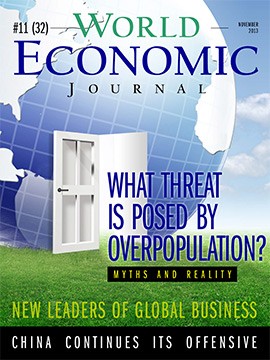Will the Euro Fall by 10%?
There is a growing clamor in the Eurozone from those who believe that the euro is overvalued, and that this is blocking the competitiveness of European products on world markets.
Arnaud Montebourg, a French government minister, said in late October that the euro should decline against the dollar by about 10%: “Ten percent is not even a devaluation, but just a correction of the exchange rate, in order to better reflect the reality of the Eurozone.” European Commissioner for Industry Antonio Tajani, according to Le Monde, agrees: “The euro is too strong now,” but stresses that he is only expressing his personal opinion and not the official position of the European Commission.
French President Francois Hollande already warned in February of the danger of an excessively strong euro. Speaking before the European Parliament in Strasbourg, he said that fiscal policy needed to be changed in the Eurozone, to make the majority of the participating countries less vulnerable to foreign exchange fluctuations. However, these proposals were not supported at that time, not least because of the position of Germany, whose exports benefit from the strong euro.
Triumph of the Weakest
Why, after Europe has been in crisis for five years, has the euro never once been slammed by the market? The top expert of the Natixis group, Evariste Lefeuvre, explains to Le Monde: “The answer is quite simple: Demand for the European currency is much greater than supply. The euro is in a sense a rarity. Furthermore, the Eurozone’s external accounts are quite balanced.”
The second fundamental reason is that the U.S. dollar is not getting any stronger. The U.S. government has repeatedly stated that it is not interested in a stronger dollar, and would in fact oppose a rise in the exchange rate, while also not allowing any significant decline.
At the end of October, the euro reached its highest level in two years, $1.38:1. Since the spring, the single currency rose almost 9%. However that is still far from its peak in 2008, when the euro was at $1.59. According to Deutsche Bank analysts, the “pain threshold” for the Eurozone is $1.37 to the euro. However, the impact of a strong currency is not the same for all Eurozone member countries. Thus in Germany, with its low unemployment and stable exports, the rate of $1.79:1 is just fine, whereas France (with a pain threshold of $1.24:1) and Italy ($1.17:1) are already suffering from the current ratio. “It’s a question of the internal competition between among European countries,”, says the head of the analytical group at Deutsche Bank.
Nevertheless, French Minister of Economy and Finance of France Pierre Moscovici says “we have not yet reached an exchange rate that would allow us to say that the euro is frankly overvalued.”
Who’s Afraid of a Strong Euro?
Europe imports a large portion of its fuel, the prices of which are denominated in dollars, so a strong euro helps save on energy costs. On the other hand, gasoline prices to consumers in Europe are continuing to rise. But the cost of imports periodically goes down, which doesn’t make the agricultural producers unhappy.
For small and medium-sized businesses it is crucial to maintain low lending rates, which is only possible if there is low inflation. But in countries with high domestic debt, the government is not interested in strengthening the euro, since that increases the cost of debt service.
Obviously a strong euro is especially unprofitable for exporting countries, with the possible exception of Germany, whose products are in demand regardless of the exchange ratio. But even there, local producers suffer losses to foreign competitors on the domestic market, and a high euro prevents them from conquering the markets of the CIS countries and Asia, which are still a quite tasty morsel for Europeans.
Experts agree that at least a partial devaluation would be considered in Europe when the rate jumps to $1.5:1. But the current ratio also gives skeptics, who are hesitant about their country joining the Eurozone, extra arguments to stick with their national currencies.
Text: Anne-Marie Vidal




Comments are closed.